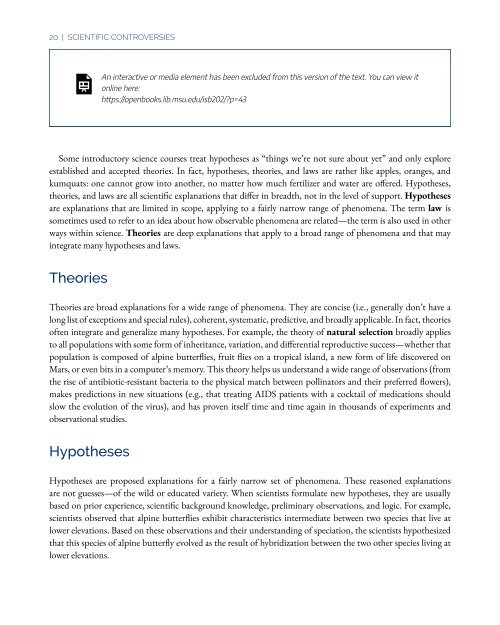An Interactive Introduction to Organismal and Molecular Biology, 2021
An Interactive Introduction to Organismal and Molecular Biology, 2021
An Interactive Introduction to Organismal and Molecular Biology, 2021
You also want an ePaper? Increase the reach of your titles
YUMPU automatically turns print PDFs into web optimized ePapers that Google loves.
20 | SCIENTIFIC CONTROVERSIES<br />
<strong>An</strong> interactive or media element has been excluded from this version of the text. You can view it<br />
online here:<br />
https://openbooks.lib.msu.edu/isb202/?p=43<br />
Some introduc<strong>to</strong>ry science courses treat hypotheses as “things we’re not sure about yet” <strong>and</strong> only explore<br />
established <strong>and</strong> accepted theories. In fact, hypotheses, theories, <strong>and</strong> laws are rather like apples, oranges, <strong>and</strong><br />
kumquats: one cannot grow in<strong>to</strong> another, no matter how much fertilizer <strong>and</strong> water are offered. Hypotheses,<br />
theories, <strong>and</strong> laws are all scientific explanations that differ in breadth, not in the level of support. Hypotheses<br />
are explanations that are limited in scope, applying <strong>to</strong> a fairly narrow range of phenomena. The term law is<br />
sometimes used <strong>to</strong> refer <strong>to</strong> an idea about how observable phenomena are related—the term is also used in other<br />
ways within science. Theories are deep explanations that apply <strong>to</strong> a broad range of phenomena <strong>and</strong> that may<br />
integrate many hypotheses <strong>and</strong> laws.<br />
Theories<br />
Theories are broad explanations for a wide range of phenomena. They are concise (i.e., generally don’t have a<br />
long list of exceptions <strong>and</strong> special rules), coherent, systematic, predictive, <strong>and</strong> broadly applicable. In fact, theories<br />
often integrate <strong>and</strong> generalize many hypotheses. For example, the theory of natural selection broadly applies<br />
<strong>to</strong> all populations with some form of inheritance, variation, <strong>and</strong> differential reproductive success—whether that<br />
population is composed of alpine butterflies, fruit flies on a tropical isl<strong>and</strong>, a new form of life discovered on<br />
Mars, or even bits in a computer’s memory. This theory helps us underst<strong>and</strong> a wide range of observations (from<br />
the rise of antibiotic-resistant bacteria <strong>to</strong> the physical match between pollina<strong>to</strong>rs <strong>and</strong> their preferred flowers),<br />
makes predictions in new situations (e.g., that treating AIDS patients with a cocktail of medications should<br />
slow the evolution of the virus), <strong>and</strong> has proven itself time <strong>and</strong> time again in thous<strong>and</strong>s of experiments <strong>and</strong><br />
observational studies.<br />
Hypotheses<br />
Hypotheses are proposed explanations for a fairly narrow set of phenomena. These reasoned explanations<br />
are not guesses—of the wild or educated variety. When scientists formulate new hypotheses, they are usually<br />
based on prior experience, scientific background knowledge, preliminary observations, <strong>and</strong> logic. For example,<br />
scientists observed that alpine butterflies exhibit characteristics intermediate between two species that live at<br />
lower elevations. Based on these observations <strong>and</strong> their underst<strong>and</strong>ing of speciation, the scientists hypothesized<br />
that this species of alpine butterfly evolved as the result of hybridization between the two other species living at<br />
lower elevations.


















